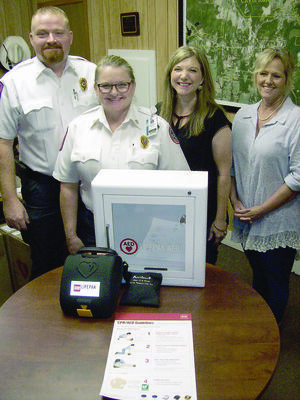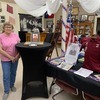UT Health provides emergency equipment
 Photo by Cristin Parker
Photo by Cristin Parker
From left, EMS Regional Director Hayden Ray and UT Health East Texas EMS Capt. Paulette Campbell present Rusk Library Director Amy Rinehart and Rusk Mayor Angela Raiborn with the city’s new defibrillators in the city manager’s office at Rusk City Hall last week. Not pictured is City Manager Jim Dunaway. The equipment, which was installed this week at four different city locations, was donated by UT Health East Texas EMS. Estimated cost of the equipment is $6,000.
The city of Rusk got a shocking donation last week.
UT Health East Texas EMS representatives presented Rusk city officials with four LifePak AEDs and secured wall mount cabinets on Thursday, June 21, at Rusk City Hall. The equipment, valued at an estimated $6,000 total, was donated to the city by UT Health East Texas EMS.
“We can’t thank them (UT Health East Texas EMS) enough,” City Manager Jim Dunaway said. “This is a really cool, big deal.”
Mayor Angela Raiborn agreed.
“We’ve been wanting these for a while,” she said. “And we’re so extremely thankful and appreciative to UT Health for this equipment.”
The AEDs, or Automated External Defibrillators, were installed at the Rusk Civic Center, the Rusk Public Library, Rusk City Hall and Rusk Fire Department’s Main Street station Monday, June 25.
“We’ve got a lot of people, especially older people, using the Civic Center and the library these days,” Library Director Amy Rinehart said. “This equipment will be a God-send, if, Lord forbid, anything should happen to anyone using our facilities.”
According to the National Heart, Lung, and Blood Institute’s website, an AED is “a portable device that checks the heart rhythm and can send an electric shock to the heart to try to restore a normal rhythm. AEDs are used to treat sudden cardiac arrest,” or when the heart suddenly stops beating. Sudden cardiac arrest usually causes death if not treated immediately.
“These units are completely automated,” UT Health East Texas EMS Regional Director Hayden Ray said as he demonstrated the equipment for city representatives. “It tells you exactly what to do and when to do it. It senses when the pads are applied and indicate when a shock needs to be delivered. It guides you through everything.”
Each AED features a calm, but firm female voice giving the instructions as well as lighted prompts and detailed written and illustrated instructions on how to use the apparatus. Each AED comes with its own storage cabinet that includes a security alarm. The city’s equipment also includes mouth guards for use during CPR, illustrated instruction posters, extra sticky pads, sterile gloves, scissors and razors to help get a patient ready for defib.
“The razor is included for those guys who are just hairy enough to keep the pads from adhering to the chest adequately,” Ray explained. “The pads are super sticky so that doesn’t happen often, but it does happen.”
UT Health East Texas will also provide tourniquets to include in the AED cabinets at a later date.
Please support The Cherokeean Herald by subscribing today!
You may also like:






